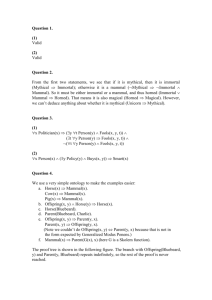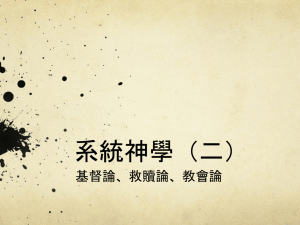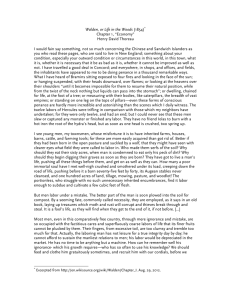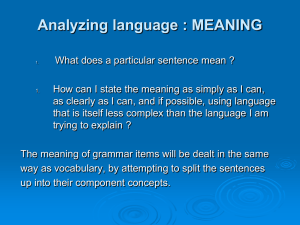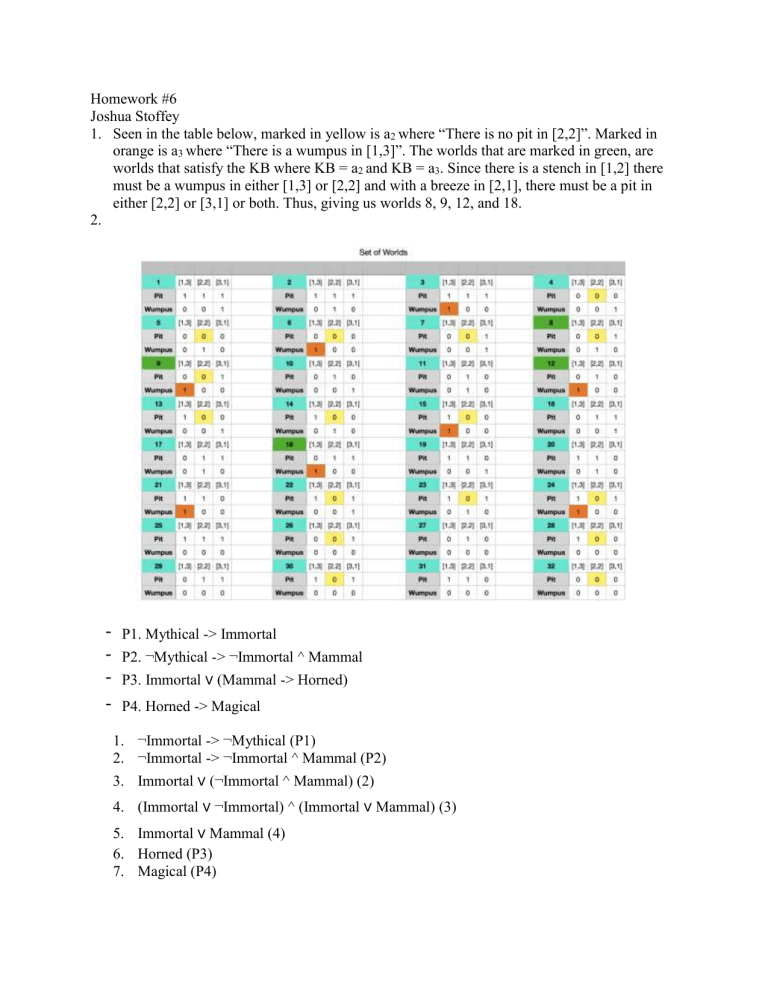
Homework #6 Joshua Stoffey 1. Seen in the table below, marked in yellow is a2 where “There is no pit in [2,2]”. Marked in orange is a3 where “There is a wumpus in [1,3]”. The worlds that are marked in green, are worlds that satisfy the KB where KB = a2 and KB = a3. Since there is a stench in [1,2] there must be a wumpus in either [1,3] or [2,2] and with a breeze in [2,1], there must be a pit in either [2,2] or [3,1] or both. Thus, giving us worlds 8, 9, 12, and 18. 2. - P1. Mythical -> Immortal P2. ¬Mythical -> ¬Immortal ^ Mammal P3. Immortal ∨ (Mammal -> Horned) P4. Horned -> Magical 1. ¬Immortal -> ¬Mythical (P1) 2. ¬Immortal -> ¬Immortal ^ Mammal (P2) 3. Immortal ∨ (¬Immortal ^ Mammal) (2) 4. (Immortal ∨ ¬Immortal) ^ (Immortal ∨ Mammal) (3) 5. Immortal ∨ Mammal (4) 6. Horned (P3) 7. Magical (P4) Thus, the unicorn is proven to be magical (b) and horned (c). However it cannot be proved to be mythical (a) since there is no indication that it is immortal. 3. - False |= True : TRUE; False has no models and entails every sentence, and since True is true in all models it is entailed by every sentence. - True |= False : FALSE. - (A ^ B) |= (A <-> B) : TRUE; There exists one model on the left-hand side that is one of the two models on the right-hand side of entailment. - A <-> B |= A ∨ B : FALSE; One model of A <-> B consists of A and B being False, which does not satisfy A ∨ B. - A <-> B |= ¬A ∨ B : TRUE; There are no instances of models where True entails False. - (A ∨ B) ^ (¬C ∨ ¬D ∨ E) |= (A ∨ B ∨ C) ^ (B ^ C ^ D -> E) : TRUE; No model that is True entails a model that is False. - (A ∨ B) ^ (¬C ∨ ¬D ∨ E) |= (A ∨ B) ^ (¬D ∨ E) : FALSE; When removing a disjunct on one side of the entailment, it allows for fewer models thus making it False. - (A ∨ B) ^ ¬(A -> B) is satisfiable : TRUE. - (A ^ B) -> C |= (A -> C) ∨ (B -> C) : TRUE; There shows no models of True that entail a model that is False. - (C ∨ (¬A ^ ¬B)) ≡ ((A -> C) ^ (B -> C)) : TRUE. - (A <-> B) ^ (¬A ∨ B) is satisfiable : TRUE. - (A <-> B) <-> C has the same number of models as (A <-> B) for any fixed set of proposition symbols that includes A, B, C : TRUE; Since C is equivalent to (A<->B) C can be cancelled out given it is always equivalent to (A<->B) which means (A<->B) will obviously have the same number of models as (A<->B). 4. - Smoke -> Smoke : VALID - Smoke -> Fire : NEITHER - (Smoke -> Fire) -> (¬Smoke -> ¬Fire) : NEITHER - Smoke ∨ Fire ∨ ¬Fire : VALID - (Smoke ^ Heat) -> Fire <-> (Smoke -> Fire) ∨ (Heat -> Fire) : VALID - Smoke -> Fire -> (Smoke ^ Heat) -> Fire : VALID - Big ∨ Dumb ∨ (Big -> Dumb) : VALID
